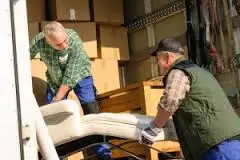Pack up all your dishes.
Make note of all good wishes.
~Guy Clark
The Dallas/Fort Worth metropolitan area is one of the most dynamic in the United States. Large companies such as Toyota are relocating plants and offices to North Texas and smaller, more entrepreneurial companies are sprouting up every day. This business growth is also driving population growth. According to the Census Bureau, Dallas-Fort Worth gained 144,704 people from July 1, 2014, to July 1, 2015, bringing its population to more than 7.1 million. This translates to about 400 new people arriving in the area every day!
This means that thousands of families are packing up and moving every month. As new residents are moving in and existing residents are moving up, a lot of people are most decidedly moving! While the possibilities of a new home are exciting to contemplate, the back pain from packing and lifting those heavy boxes is not.
Saving Your Back on Moving Day
Just as there is a correct way to wrap and pack up those dishes, lifting that box in which they are stored requires some experience and planning too. Otherwise, the new house will become the “House of Pain.” Back pain, caused by improper lifting, can be mild or severe, but with proper lifting technique it can also be avoided or minimized.
 According to Dr. Akwasi Boah a neurosurgeon at Texas Back Institute, there are at least four lifting techniques to remember on moving day. By following these directions, the only trauma a moving family will experience will be trying to remember where they packed the electric can opener!
According to Dr. Akwasi Boah a neurosurgeon at Texas Back Institute, there are at least four lifting techniques to remember on moving day. By following these directions, the only trauma a moving family will experience will be trying to remember where they packed the electric can opener!
“Always lift boxes and furniture with your legs, not with your back,” Dr. Boah said. “This is the most important rule to remember. The leg muscles are much stronger than the other muscles in the body, including the back muscles. When you keep your back straight and squat to pick up the item being lifted, the weight is on the legs and not the back. In other words, you can therefore place your center of gravity in your hips and pelvis instead of dispersing it within the facet joints of your thoracolumbar spine.
“It is also important to avoid twisting around when rising with the load no matter what the size of the item being lifted,” he said. “Even if the box or item seems to be light, the twisting motion can tweak your back and you will likely be miserable for the rest of the day and night. This is most likely due to muscular and tendinous strain as the back muscles (aka erector spinae complex) insert on the spinous processes in the midline of your back.
 “Another rule for moving is to keep the box or other item you are moving close to your body,” Dr. Boah noted. “If the load is farther out (away from your body), the lifting ‘lever’ is extended, causing more downward force. By keeping the item to be lifted close to your body, that downward force is decreased and it results in fewer strains on the back.
“Another rule for moving is to keep the box or other item you are moving close to your body,” Dr. Boah noted. “If the load is farther out (away from your body), the lifting ‘lever’ is extended, causing more downward force. By keeping the item to be lifted close to your body, that downward force is decreased and it results in fewer strains on the back.
“Finally, never try to ‘yank up’ an item being lifted,” he said. “More back strains result from this than any other action. Test its weight first. If it is too heavy to be easily lifted, go get a dolly or assistance.” Work smarter not harder!
When it’s too Late and the Damage is Done
Since most people are not professional movers and thus don’t lift heavy items on a regular basis, building up the core muscles BEFORE moving day is advisable. Having a regular exercise regime which includes core strength-building activities such as ‘planking’ can help avoid these back strains from lifting. A stronger core results in your back requiring less effort to support added weight to your trunk!
If, however, moving day takes its toll and the searing back pain that most have experienced at one time or another occurs, Dr. Boah suggests the following actions:
“Stop lifting as soon as you feel the discomfort and rest,” he said. “The worst thing you can do is to try to ‘work through’ the pain. Next, as soon as possible place an ice-pack on the part of the back that is injured. Be careful to remove the ice and let the skin warm up every 15-minutes or so.
“As for medications, mild anti-inflammatories such as Ibuprofen or Tylenol will usually help stop the intensity of the pain,” Dr. Boah said. “Try to take it easy in the next few days and continue taking these medications for relief. If the pain does not subside after two or three weeks, or if it continues to intensify and includes ‘shooting’ pain or weakness in the legs/feet, you should immediately see a physician or spine specialist.”


